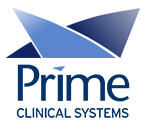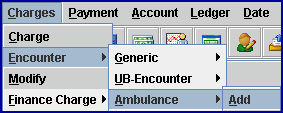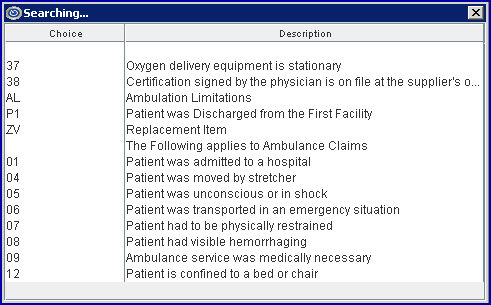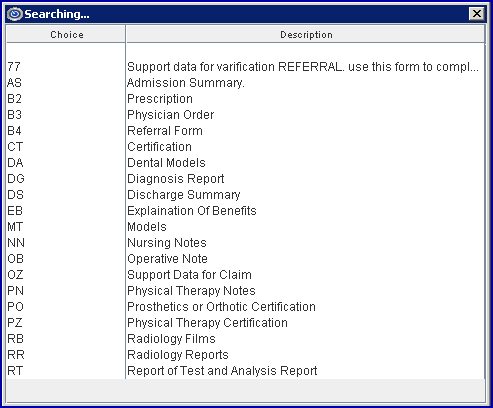
Intellect™
CHARGES MENU OPTIONS

Ambulance Encounter
To be covered, ambulance services must be medically necessary and reasonable. Medical necessity is established when the patient's condition is such that use of any other method of transportation is contraindicated . In cases in which some means of transportation other than an ambulance could be used without endangering the individual's health, whether or not such other transportation is actually available, no payment may be made for ambulance services.
As a result, this option is used when submitting a claim for payment and to provide information on the claim to substantiate the patient's need to be transported by ambulance versus other forms of transportation.
See instructions to add an ambulance encounter.
Updates:
Effective version 16.05.20
In prior versions, for the Internal Control Number (ICN) to be included in the Electronic Claims, the ICN had to be entered in the <Internal Control> field. Effective this version, Intellect now pulls the ICN number from the charge. This is handled by Intellect when auto-posting is used to post payments from the payers. This modification is NOT retroactive. Additionally, this ICN now also prints on the printed EOB from Intellect.
Effective version 14.07.01
When Intellect looks for a Referring Provider (a.k.a. ordering physician), Intellect first looks at the encounter screen for either <Ordering Provider> or <Supervising Provider> and, when either is blank, Intellect looks at the Utility --►Set Up --►Parameter <Referring> setting and pulls the referring provider based on the setting.
Effective Version 9.12.27
For clients who complete most of the Encounter screen fields with the same values for each patient, version 9.12.27 allows a 'default' record to be set up with the value to be carried over to all new Encounters.
To set up a default screen, go to Charges --►Encounter. Select the type of Encounter screen the office uses (the sample below is for Generic Encounter), then select Modify. At the <Patient Account No> field, enter 0 (zero). At the <Encounter #> field, enter 0 (zero).

Complete any field to default to all new Encounters entered.
Setting up the default encounter screen does NOT affect any encounters already entered.
1. To add ambulance encounter information to a patient's account in Intellect, go to Charges --► Encounter --►Ambulance --►Add

The Add Ambulance screen displays.
(Effective Version 9.12.18, fields <Hospitalization From> and <Hospitalization To> were removed from this screen.)

2. Patient's Account No 
2.1 When not already displayed, type the patient's account number.
2.2 Enter the account number, OR type up to 6 characters of the last name and press the [F2] key. To select the code from the list, either highlight the record and press the [Enter] key, OR double-click on the record.
3. Patients Name 
3.1 The patient's name displays. This is a read-only field and may not be modified.
3.2 The display is formatted Last, First.
4. Encounter # 
4.1 This number is assigned automatically when adding a new record.
4.2 This number is used to individually display and identify this encounter.
5. Encounter Description 
5.1 Enter a meaningful description for this encounter.
6.1 Enter the street address information for 'the point of pick up' to report the origin information.
6.2 Electronic claims submission uses Loop 2300 NTE01 which indicates additional Information is being added, and NTE02 is a free form field which can accommodate this address.
7. Origin Zip 
7.1 Version 9.12.13 - New field added
7.2 This field is used with ANSI 5010.
7.3 Enter the zip code for the point of pick up to report the origin information.
7.4 NOTE: Since the zip code is used for pricing, more than one ambulance service may be reported on the same claim for a beneficiary if all points of pickup have the same zip code. Suppliers must prepare a separate claim for each trip if the points of pickup are located in different zip codes.
8. City 
8.1 Version 9.12.13 - New field added
8.2 This field is used with ANSI 5010.
8.3 Enter the city for the point of pick up to report the origin information. If the zip code entered in the <Origin Zip> field (see above) exists in the database, this field is defaulted. If not, enter the city name.
9. State 
9.1 Version 9.12.13 - New field added
9.2 This field is used with ANSI 5010.
9.3 If the zip code entered in the <Origin Zip> field (see above) exists in the database, this field is defaulted. If not, use the drop-down list to select the 2-character state code for the point of pick up to report the origin information.
10.1 Use this field to enter the point of pick up zip code.
10.2 To satisfy CMS, enter the zip code for the point of pick up. Since the zip code is used for pricing, more than one ambulance service may be reported on the same claim for a beneficiary if all points of pickup have the same zip code. Suppliers must prepare a separate claim for each trip if the points of pickup are located in different zip codes. Claims without a zip code in item 23, or with multiple zip codes in item 23, are returned as unable to be processed. 837 (3051) and (3032) are to report the origin information (e.g., the zip code of the point of pickup) in loop 2310A (Facility Address). NM1 is required.
10.3 Intellect uses this information to complete the PRIOR AUTHORIZATION NUMBER in Box 23 of the CMS 1500 form or for electronic claims submission Loop 2300 REF01 G1.
![]()
11. Authorized Visits Left 
11.1 Leave blank.
12. Total Authorized Visits 
12.1 Leave blank.
13. Related: Accident (A/O/N) 
13.1 Version 9.12.18 - New field added.
13.2 To view the list of codes with descriptions, click on the field, OR press the → (right arrow) on the keyboard.

13.3 To view the list of only the codes click on the arrow. To select, double-click on the correct code, OR use the ↑ (up) and ↓ (down) arrows to highlight the correct code, and then press the [Enter] key to select.
14.1 This is for electronic claims submission and is used in conjunction with the <Condition or Response Code> field on this screen when it is set to 'Y'. This field uses Loop 2300 CRC03.
14.2 If a Condition Indicator is to be sent, select an appropriate choice from the drop-down.
14.3 To view the list of codes with descriptions, click on the field OR press the → (right arrow) on the keyboard.

14.4 To view the list of only the codes, either click on the arrow, OR press the → (right arrow) on the keyboard. To select, double-click on the correct code, OR use the ↑ (up) and ↓ (down) arrows to highlight the correct code, and then press the [Enter] key to select.
15. Condition Indicator2 
15.1 This is for electronic claims submission and is used in conjunction with the <Condition or Response Code> field on this screen when it is set to 'Y.' This field uses Loop 2300 CRC04.
15.2 If a second Condition Indicator is to be sent, select an appropriate choice from the drop-down.
15.3 To view the list of codes with descriptions, click on the field OR press the → (right arrow) on the keyboard.
15.4 To view the list of only the codes either click on the arrow, OR press the → (right arrow) on the keyboard. To select, double-click on the correct code, OR use the ↑ (up) and ↓ (down) arrows to highlight the correct code, and then press the [Enter] key to select.
16. Condition Indicator3 
16.1 This is for electronic claims submission and is used in conjunction with the <Condition or Response Code> field on this screen when it is set to 'Y.' This field uses Loop 2300 CRC05.
16.2 If a third Condition Indicator is to be sent, select an appropriate choice from the drop-down.
16.3 To view the list of codes with descriptions, click on the field OR press the → (right arrow) on the keyboard.
16.4 To view the list of only the codes either click on the arrow, OR press the → (right arrow) on the keyboard. To select, double-click on the correct code, OR use the ↑ (up) and ↓ (down) arrows to highlight the correct code, and then press the [Enter] key to select.
17. Condition Indicator4 
17.1 This is for electronic claims submission and is used in conjunction with the <Condition or Response Code> field on this screen when it is set to 'Y.' This field uses Loop 2300 CRC06.
17.2 If a fourth Condition Indicator is to be sent, select an appropriate choice from the drop-down.
17.3 To view the list of codes with descriptions, click on the field OR press the → (right arrow) on the keyboard.
17.4 To view the list of only the codes either click on the arrow, OR press the → (right arrow) on the keyboard. To select, double-click on the correct code, OR use the ↑ (up) and ↓ (down) arrows to highlight the correct code, and then press the [Enter] key to select.
18. Condition Indicator5 
18.1 This is for electronic claims submission and is used in conjunction with the <Condition or Response Code> field on this screen when it is set to 'Y.' This field uses Loop 2300 CRC07.
18.2 If a fifth Condition Indicator is to be sent, select an appropriate choice from the drop-down.
18.3 To view the list of codes with descriptions, click on the field OR press the → (right arrow) on the keyboard.
18.4 To view the list of only the codes either click on the arrow, OR press the → (right arrow) on the keyboard. To select, double-click on the correct code, OR use the ↑ (up) and ↓ (down) arrows to highlight the correct code, and then press the [Enter] key to select.
19. Condition or Response Code 
19.1 This is for electronic claims submission and is used in conjunction with the Charges --► Encounter --►Ambulance <Condition Indicator 1, 2, 3, 4, 5> fields (see above). It uses Loop 2300 CRC02.
19.2 Select 'Y' (yes) if <Condition Indicators> are included.
20. Code Category 
20.1 To view the list of codes with descriptions, click on the field OR press the → (right arrow) on the keyboard.

20.2 To view the list of only the codes either click on the arrow, OR press the → (right arrow) on the keyboard. To select, double-click on the correct code, OR use the ↑ (up) and ↓ (down) arrows to highlight the correct code, and then press the [Enter] key to select.
21. Patient Weight 
21.1 This is for electronic claims submission. It uses Loop 2300 CR102.
21.2 Type in the weight of the patient in whole numbers.
22.1 This is used for electronic submission in Loop 2300 CR103.
22.2 Accept the default 'I' initial OR use the drop-down list to make an alternate selection.
22.3 To view the list of codes with descriptions, click on the field OR press the → (right arrow) on the keyboard.

22.4 To view the list of only the codes either click on the arrow, OR press the → (right arrow) on the keyboard. To select, double-click on the correct code, OR use the ↑ (up) and ↓ (down) arrows to highlight the correct code, and then press the [Enter] key to select.
23.1 This is for electronic submission. It uses Loop 2300 CR104.
23.2 Accept the default 'A' OR use the drop-down list to make an alternate selection.
23.3 To view the list of codes with descriptions, click on the field OR press the → (right arrow) on the keyboard.

23.4 To view the list of only the codes either click on the arrow, OR press the → (right arrow) on the keyboard. To select, double-click on the correct code, OR use the ↑ (up) and ↓ (down) arrows to highlight the correct code, and then press the [Enter] key to select.
24.1 This is for electronic submission, type the 'Loaded Mileage' in whole miles. It fills Loop 2300 CR106.
24.2 The ambulance fee schedule provides a separate payment amount for mileage. For payment purposes the term mileage refers to loaded mileage or the number of miles for which the beneficiary is transported in the ambulance.
25. Injury Date 
25.1 Effective version 9.12.18 - New field added.
25.2 Effective version 14.09.29: If the <DOI> field on the Registration --►Worker --►Worker Insurance screen is already filled, Intellect pulls the date from that field to fill this field.
25.3 For versions prior to 14.09.29, enter the date of the patient's injury.
25.4 Note: For Ambulance billing, enter 'T' in the <Status> field on the Utility --►Procedure --►Procedure screen to allow this date to populate,
26. Round Trip Purpose Description 
26.1 This is used for electronic submission. It is required if CR103 (Ambulance Transport Code) = 'X - Round Trip,' otherwise it is not used. It uses Loop 2300 CR109.
26.2 This field can be entered once per detail line. Ambulance providers can use this field to provide additional information regarding the circumstances of a round trip transport or for other medical necessity documentation; i.e., round trip narrative 80.
27. Stretcher Purpose Description 
27.1 This is for electronic submission. It is required if needed to justify usage of a stretcher. It uses Loop 2300 CR110
27.2 This field can be entered once per detail line. Ambulance providers can use this field to provide additional information regarding the patient’s condition that warranted the use of a stretcher or for other medical necessity documentation; i.e., stretcher narrative 80.
28.1 This field is used to designate a supplemental report type that will be forwarded separately. It works with the <Report Transmission Code> and <Identification Code> fields on this screen (see below). It is included in electronic claims submission Loop 2300 PWK01.
28.2 To view the list of codes with descriptions, click on the field OR press the → (right arrow) on the keyboard.

28.3 To view the list of only the codes either click on the arrow, OR press the → (right arrow) on the keyboard. To select, double-click on the correct code, OR use the ↑ (up) and ↓ (down) arrows to highlight the correct code, and then press the [Enter] key to select.
29.1 This field is used to designate a supplemental report type that will be forwarded separately. It works with the <Report Type Code> and <Identification Code> fields on this screen. It is included in electronic claims submission Loop 2300 PWK02.
29.2 To view the list of codes with descriptions, click on the field OR press the → (right arrow) on the keyboard.

29.3 To view the list of only the codes either click on the arrow, OR press the → (right arrow) on the keyboard. To select, double-click on the correct code, OR use the ↑ (up) and ↓ (down) arrows to highlight the correct code, and then press the [Enter] key to select.
30.1 This is used in electronic claims submission.
30.2 Type the Attachment Control Number from the pre-printed MEDI-CAL CLAIM Attachment Control Form. The form must accompany the supporting documentation.
30.3 PCM users only. Effective version 14.07.01:
30.3.1 With the focus in this field, press the [F2] key twice to display a list of document files pulled from the Progress Notes in PCM (the list does NOT include files generated in Intellect or manually saved to the /home/staff/EB_ATTACHMENT folder).
30.3.2 To display only a certain type of file, enter the beginning letters of the file and then press [F2].
30.3.3 Click on the appropriate file to select it. Multiple files may be selected by holding down the [Ctrl] and [Shift] keys while clicking on the desired files. The file's Document Id displays.
31.1 The Claim Frequency Code is used only for electronic billing, and indicates what type of claim it is. Examples include: an original submission, a corrected claim which is being resubmitted, a replacement claim, or a voided claim. The default is set to 1: Original Submission. Prior to adding this field on the Encounter screen the system submitted all claims with Claim Frequency Code 1. Loop 2300 CLM05 - 3.
31.2 Accept the default '1' Original Submission OR use the drop-down list to make an alternate selection.
31.3 To view the list of codes with descriptions, click on the field OR press the → (right arrow) on the keyboard.

31.4 To view the list of only the codes either click on the arrow, OR press the → (right arrow) on the keyboard. To select, double-click on the correct code, OR use the ↑ (up) and ↓ (down) arrows to highlight the correct code, and then press the [Enter] key to select.
31.5 When making an appeal for a Worker's Comp claim, in addition to this field, the <Internal Control>, <Appeal Type>, and <Appeal Documentation File> fields MUST be filled.
31.6 Effective version 18.08.31: When this field is set greater than 1 and the <Internal Control> field is blank, the ICN # that comes with the ERA file is printed in Box 22 on the HCFA 1500 and also sent electronically.
32. Rx Number 
32.1 Enter the unique identification number assigned by the pharmacy or supplier to the prescription. It uses Loop 2410 REF02 with the Qualifier XZ.
33.1 EDS assigns each claim an Internal Control Number (ICN) systematically when it is received electronically or by mail. Processing or returning the claim constitutes EDS’ final action on that claim. A resubmission of the same service is considered a new claim. Each claim sent to EDS is assigned an ICN automatically, which is used to track the claim. The ICN is made up of 13 digits following a specific format. The format of the ICN enables the determination of when the EDS actually received the claim.
33.2 This is used when rebilling a corrected claim to provide to the insurance the original claim control number on a denied claim.
33.3 This number is included in the electronic transmission for all claims. It is a number assigned by the payer to identify a claim. The number is usually referred to as an Internal Control Number (ICN), Claim Control Number (CCN), or a Document Control Number (DCN). CLM, 2300 REF02 is the Loop and segment:
CLM*1.608.1.491.G*250***11:B:7*Y*A*Y*Y*P
REF*F8*20024E011000 ß
33.4 When making an appeal for a Worker's Comp claim, in addition to this field, the <Claim Frequency Code>, <Appeal Type>, and <Appeal Documentation File> fields on this screen MUST be filled.
33.5 Effective version 18.08.31: When this field is blank and the <Claim Frequency Code> field is set greater than 1, the ICN # that comes with the ERA file is printed in Box 22 on the HCFA 1500 and also sent electronically.
34. Ordering Provider 
34.1 Version 9.12.18 - New field added.
34.2 Enter the name or number of the Provider who ordered the ambulance.
35.1 This field is used to identify the level of the appeal, if needed.
35.2 Use the drop-down list and select the appropriate option:

35.3 When making an appeal for a Worker's Comp claim, in addition to this field, the <Claim Frequency Code>, <Internal Control>, and <Appeal Documentation File> fields on this screen MUST be filled.
36.1 If there is documentation that needs to be sent to the insurance company, enter the file name of the documentation.
36.2 Files with valid file names are sent directly to the insurance company.
36.3 Effective version 14.07.01:
Clients with Intellect only:
36.3.1 Create and save Appeal Document(s) files in the /home/staff/EB_ATTACHMENT folder. SBRs may also be saved as a .pdf to the /home/staff/EB_ATTACHMENT folder and attached as appeal documents.
36.3.2 Type the exact file name in this field. Note: This field is case-sensitive.
Clients with both Intellect and Patient Chart Manager (PCM) only:
36.3.3 With the focus in this field, press the [F2] key twice to display a list of document files pulled from the Progress Notes in PCM (the list does NOT include files generated in Intellect or manually saved to the /home/staff/EB_ATTACHMENT folder).
36.3.4 To display only a certain type of file, enter the beginning letters of the file and then press [F2].
36.3.5 Click on the appropriate file to select it. Multiple files may be selected by holding down the [Ctrl] and [Shift] keys while clicking on the desired files. The file's Document Id displays.
36.4 When making an appeal for a Worker's Comp claim, in addition to this field, the <Claim Frequency Code>, <Internal Control>, and <Appeal Type> fields on this screen MUST be filled.
37. When the information is completely entered, select one of these options:

37.1 Click [Add] to clear the screen and return the focus to the <Patient Account No> field, saving the new encounter.
37.2 Click [Clear] to display this message:

37.2.1 Click [Yes] to clear the screen and return the focus to the <Patient Account No> field, saving the new encounter.
37.2.2 Click [No] to clear the screen and return the focus to the <Patient Account No> field without saving.
37.3 Click [Exit] to display this message:

37.3.1 Click [Yes] to clear the screen and return the focus to the main Intellect screen, saving the new encounter.
37.3.2 Click [No] to clear the screen and return the focus to the main Intellect screen without saving.
Effective Version 9.12.18, these fields (previously numbered 24 and 25, as shown below) were removed from this screen:
24. Hospitalization From ![]()
24.1 For either paper or electronic claim submission. Required on all ambulance claims/encounters when the patient was known to be admitted to the hospital.
24.2 Type the admit date of the patient if hospitalized.
24.3 Intellect completes box 18 of the CMS 1500 form with this date. Or Loop 2300 DTP*435*D8*.
25. Hospitalization To ![]()
25.1 For either paper or electronic claim submission. Required on all ambulance claims/encounters when the patient was known to be admitted to the hospital. Also required on inpatient medical visits claims/encounters.
25.2 Type the discharge date of the patient if hospitalized.
25.3 Intellect completes box 18 of the CMS 1500 form with this date. Or Loop 2300 DTP*096*D8*.